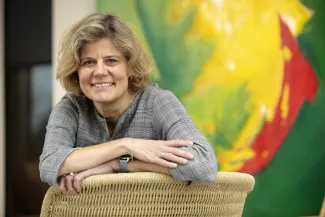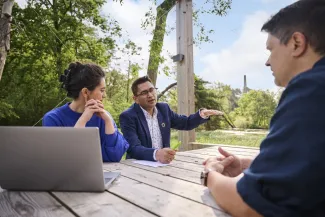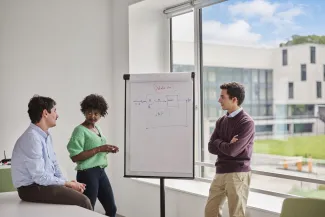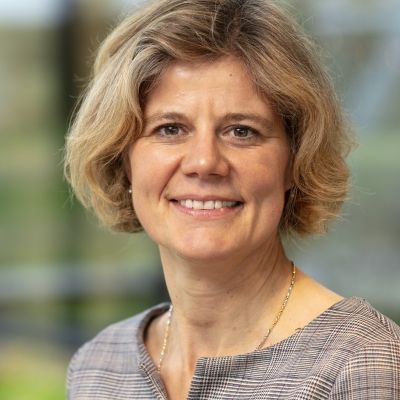
Helping our world thrive for at least 1,000 more years
Over the past months, VITO has been working hard to translate its renewed strategy into clear and accessible communication. We clearly aim to expand our impact by supporting companies, governments and citizens as a reliable partner in their sustainability transition. How do we distinguish ourselves as VITO and how can we contribute to a positive transition narrative for a more sustainable society in Flanders, Europe, and the world? At VITO, we brought this together into a clear story, which CEO Inge Neven will explain here.
To be prepared for the challenges of the coming decades, the Flemish government is firmly committing to sustainable innovation. "We are clearly trusted by the Flemish government as the internationally renowned research organisation in technology and innovation for the green transition," says Inge Neven, CEO of VITO.
"Our mission, as outlined in the management agreement, is to strengthen Flanders' competitiveness in Europe and globally by attracting, developing, and integrating both Flemish and international talent into the region's economic fabric. At the same time, we are also contributing to the European Green Deal, which has since evolved into the European Clean Deal, where we seek ecological solutions that also provide economic benefit – the major challenge for the coming years in Flanders and Europe. The two pillars Europe should strongly focus on—electrification and circularity—are precisely the areas in which VITO has extensive expertise, that works out well.
To realise our ambitions and support industry and governments as well as we can, we are currently – for example – building a new flagship lab building at our site in Mol, where we are expanding our unique lab, upscaling and pilot infrastructure. At VITO, we always conduct both scientific and techno-economic analyses, spanning from the lab phase to near-industrial production scale. This approach also enables us to develop technological solutions that are economically viable, practically implementable, and minimising investment risks for companies.”
VITO's story: the science-to-technology partner for companies, governments and citizens
“Too often, it still turns out that people don't know exactly what VITO does, or how and for whom we work. The research activities are so broad, and the topic of ‘sustainability’ has now become almost universal. For example, our 1,300 experts are working in more than 40 research areas; this is not easy to translate into a single sentence. We felt the need for a clear narrative and a refined positioning, so that businesses, governments, citizens, and prospective visioneers can find us more easily and quickly,” Inge continues.
Ultimately, it always comes down to the same thing: VITO and its 1,300 specialised and motivated experts turn scientific insights into practical technologies, AI solutions, and solid advice. That makes us the 'science-to-technology partner' for companies, governments and all of society. We have a single objective there: to help our world thrive for at least 1,000 more years.”

Three impact areas, three pillars
VITO concentrates its research activities on three key areas where the organisation aims to make the greatest impact in Flanders, Europe, and globally: a regenerative economy, a healthy living environment, and resilient ecosystems.

A regenerative economy
“Along with our partners, we are a driving force in the transition to a regenerative economy. This puts economy and ecology in balance: we aim to drive economic prosperity through the sustainable use of resources while reinforcing planetary boundaries. Circular and bioeconomy, water and energy are points of focus in this field. But we are also looking at the underlying connection between energy, resources and water. The goal is to (re)use and optimise each building block or molecule, and water and energy source for as long and as efficiently as possible.
A healthy and sustainable living environment
A healthy and sustainable living environment for all is a second impact area for VITO. Here, we focus on how to maintain a harmonious balance between the human environment, nature, agriculture, and industry. We provide insights into living conditions that enhance the health and well-being of citizens. We demonstrate how to preserve clean air, water, and soil in densely populated environments, and we ensure access to fossil-free, healthy, and comfortable housing in resilient living environments.
Resilient ecosystems
Finally, we are committed to resilient ecosystems. The climate is becoming ever more erratic and unpredictable. The goal remains to limit temperature rise and achieve carbon neutrality in Europe by 2050. Resilience and adaptability are essential to achieving this. This is why we are helping companies and authorities with solutions for climate mitigation, for example for carbon capture, utilisation and storage (CCUS).

We are also developing climate adaptation technologies to enhance resilience to the impacts of climate change. For instance, we are investigating how to make cities heat-resistant and how to prevent and tackle floods and droughts. Our scientists combine detailed satellite imagery with science-based digital models and physical measurements of land, water and air to make precise observations and predictions. We aim to create ecosystems that are more resilient to disasters, thereby enhancing our overall resilience and security.
Three strong pillars
How will we make a success of this mission? Thanks to our three strong pillars: our multi-disciplinary expertise, our unique lab/data, upscaling and testing infrastructure, and our systemic approach, including the collaboration with our extensive network of stakeholders. Together, we translate science into innovative technologies and solutions that are effective, even in today's complex reality. This is how we aim to help our world thrive for at least 1,000 more years.”



